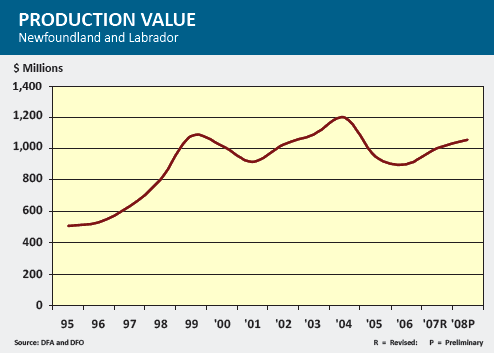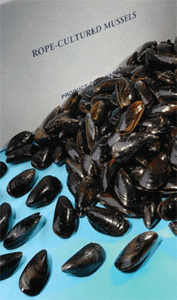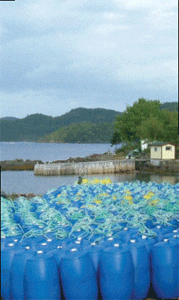Production value exceeded $1 billion and the industry generated direct employment for approximately 24,000 residents located in over 500 communities throughout the province. Shellfish continued to play a significant role in capture fisheries, accounting for over 194,000 tonnes. Aquaculture production jumped to record levels, surpassing 11,000 tonnes.
In 2008, Newfoundland and Labrador seafood was shipped to over 55 countries. While export volume decreased by almost 10 percent, export value remained over $800 million, similar to previous years. This was due to high market prices for key species and favourable exchange rates in key markets such as the United States and Japan.

Aquaculture Sector
The province’s aquaculture industry continued to expand in 2008. Production jumped to record levels, reaching 11,545 tonnes, up 39.1 percent from 8,300 tonnes in 2007. Key species in the province’s aquaculture production are Atlantic salmon, steelhead trout and blue mussels. Efforts continued in 2008 to commercialize cod aquaculture.

Aquaculture companies continued to produce primary and secondary products that entered the Canadian and U.S. markets. Export value of aquaculture products spiked in 2008, rising to $63.1 million, a significant 57.8 percent increase from $40 million in 2007. This can be attributed to increased production volume for Atlantic salmon and steelhead, favourable exchange rates and strong market prices. This growth also accounted for increased employment levels in the aquaculture sector, which currently employs 655 individuals.
Salmonid aquaculture is concentrated on the south coast in Bay d’Espoir and Fortune Bay. This area produces approximately 90 percent of the province’s salmonids. In 2008, a high volume of smolt was introduced, which will bode well for continued expansion of this sector.
Shellfish culture (mainly blue mussels) is carried out in a variety of locations around the province; however, it is concentrated in the Green Bay, Notre Dame Bay region. This area produces between 80 to 90 percent of the province’s cultured shellfish.

Outlook for 2009
Capture Fisheries
The Newfoundland and Labrador fishing industry faced another challenging year in 2008. In 2009, the provincial seafood sector will continue to adjust to the changing global economy.
Fish landings in 2009 are expected to fall slightly below those of 2008. Higher groundfish landings are projected which will partially offset an expected decline in shellfish landings. Higher yellowtail catches are anticipated to contribute to increased groundfish landings. Pelagic landings will remain dependent on resource availability. Shellfish landings, with the exception of shrimp, are expected to fall modestly. Shrimp landings are expected to increase due to higher inshore shrimp quotas.
Landed value is projected to fall slightly, as a result of lower landings and downward pressure on market prices for some species due to weaker demand in key markets combined with higher inventories. An unfavorable exchange rate with the U.K. may impact negatively on exports to this market. Favorable exchange rates with the U.S. and Japan, however, will impact positively on the value of our province’s seafood and will likely offset any price reductions in these markets. This, combined with the recent reduction in fuel prices and higher prices for some groundfish and shellfish products, may alleviate some negative effects from the global economic downturn.

Aquaculture Sector
A rise in production is expected for the aquaculture sector. Growth in salmonid production in particular is anticipated to continue. Despite the global financial crisis, this sector will see further investment in 2009. Mussel production is expected to remain relatively constant with prices staying on par with the previous year. Access to capital may slow new investment in the sector.
Export value is anticipated to increase in 2009, mainly due to increased levels of production. No decrease in market price for aquaculture products was observed in the fourth quarter of 2008. A favorable exchange rate with the U.S. will bode well for the sector as the majority of production is exported to this market.
March 2009


